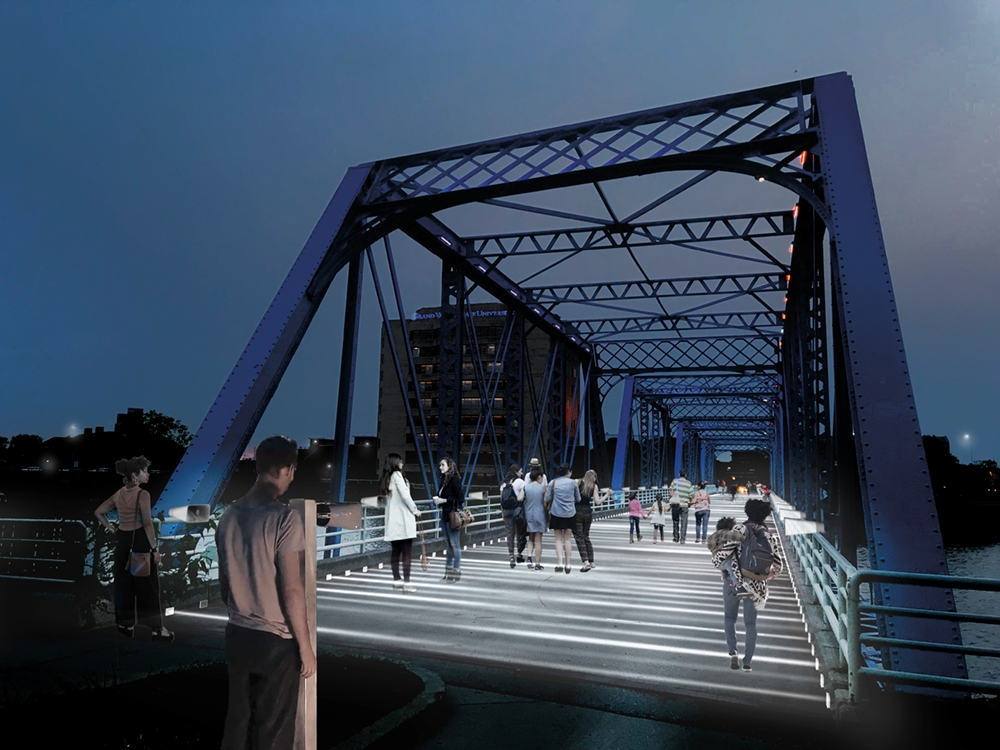For its 10th anniversary, ArtPrize is reinventing itself. The Grand Rapids-based art festival, if not moldering, had started to show its age. Last year, MLive reported that registration for public voting numbered only 32,613 people, the lowest total in the festival’s history.
Beginning this year, large-scale projects will alternate with traditional ArtPrize events. Debuting Sept. 7 is Project 1: Crossed Lines, which presents five works of art, each a meditation on lines of division and community.
Narrowing down from more than 1,200 artworks to five obviously represents a significant shift in focus.
“The main reason we made the change is that we wanted to find a way to better support the kinds of public art projects that people like at ArtPrize, and have the most lasting impact,” said Kevin Buist, artistic director of ArtPrize. “For the past few years of ArtPrize, we’ve been giving out grants to fund large outdoor projects, and this has been really successful. We wondered what would happen if we doubled down on that approach by offering more resources to artists, as well as more time and installation coordination from our team.”
Asked if any venues or artists had expressed concern about the change in format, he said a few had, but more had mentioned appreciation for the extra preparation time for next year’s event.
One familiar venue to ArtPrize visitors is the Blue Bridge. This year, it will house Rafael Lozano-Hemmer’s Voice Bridge, a piece that will feature speakers and 400 lights. Visitors will be able to record messages, the volume of which will determine how brightly the associated lights will shine. The end result will be a literal representation of the ways in which residents’ voices can change Grand Rapids.
Heather Hart’s Oracle of Lacuna, split between Rosa Parks Circle and MLK Park, will consist of the tops of homes, as if most of the structures had been swallowed by sinkholes or had melted into the ground. They will serve as venues for exploration — visitors are encouraged to enter the attics — and of live performances.
Olalekan Jeyifous’ Crown Ether will recreate his sculpture The Boom and the Bust at the corner of Monroe Ave. and Louis St. An abstract piece, its ambition is to represent the gulf between how some of us get to live and how others are forced to. A rendering shows a man with a cell phone standing beside a skyscraper, its center hollowed out to allow for red buildings reminiscent of Monopoly game pieces.
Tanglefoot Building will host Paul Amenta and Ted Lott’s Radio Station (Miami Folly II). The Project 1 site describes it as a work that “will create an environment that addresses issues of accessibility in both form and function.” It will feature ramps and landings, making the site accessible to all visitors, and promises “performances and interventions.”
Finally, Amanda Browder’s Spectral Locus will be a large, brightly colored installation of fabric in several locations: a community building in Martin Luther King Jr. Park, four skywalks, and a building at Tanglewood.
Katherine Hagman, the volunteer and visitor engagement manager for ArtPrize, spoke of the more than 300 local volunteers who had committed time to sewing fabric for Browder’s pieces. “The volunteers are as young as two years old,” she said. “It’s been a really incredible community effort.” Fabric was donated by businesses and local citizens. Some of the pieces have storied pasts — fabric from shirts and jackets retrieved from the closets of lost parents or siblings have been weaved into the greater whole.
The challenge of any large new event is explaining to the public what it is. Margaret Paxton, communications assistant, compared it to the first year of ArtPrize, when people knew something was going to happen but may not have been sure exactly what. Her goal is to contribute to the ways in which Project 1 hopes to strengthen community ties and engage people who may not have participated in ArtPrize before.
Becca Guyette, director of learning and engagement, is ensuring that ArtPrize continues to educate as broadly as possible. To that end, she works to help secure transportation funding for local schools so students will be able to see the art up close. “These days, face-to-face is hard to find,” she said, referring to the way screens have changed the way we live. Her team has created lesson plans to help ensure students and educators are able to make the most out of the experience.
The Sept. 7 launch will be a spectacle, or several spectacles. BANDALOOP, a group of performers who use climbing devices to secure them as they dance on the sides of buildings, describe their work as not death-defying but life-affirming — it may be both. Various musicians and groups will perform, including the Grand Rapids Ballet, and artists will converse.
Opening night will feature a performance by Drag Syndrome, a London-based group of people with Down syndrome who perform in drag, providing a venue for joyful expression by people often willfully ignored by the larger society.
Asked what would define a successful Project 1, Buist said that it may be difficult to know for some time. “Project 1 is a turning point. Of course we would like to see big crowds,” he said. But the event, while narrower than ArtPrize, may prove to be richer. “These artworks are geared toward a deeper dive, repeat visits, and forms of interaction and participation that are often more intimate and harder to see.”





